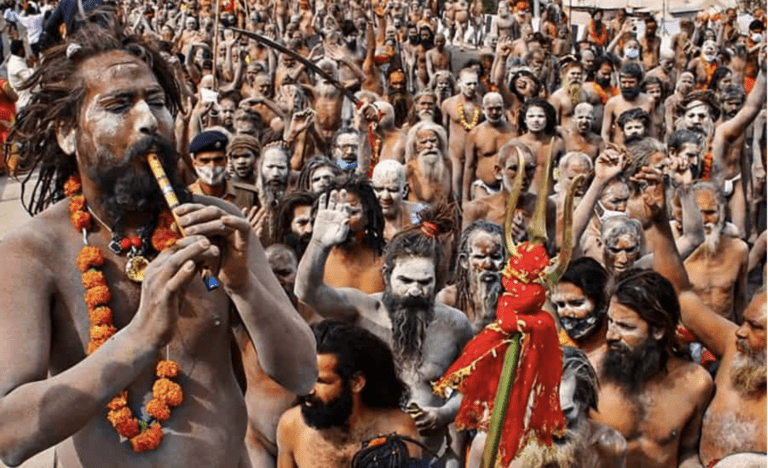The Purn Kumbh Mela is a majestic Hindu pilgrimage that occurs every 12 years, attracting millions of devotees to the sacred Ganges River. It’s a spectacular display of faith, culture, and spirituality. The mela features ritual baths, sacred processions, and discourses by revered saints and seers. The event embodies the essence of Hinduism, promoting unity, harmony, and self-reflection. It’s a once-in-a-lifetime experience that leaves an indelible mark on the hearts of its participants.
A dip at the Sangam cleanses not just the body, but also the soul.
Hindus do not regard rivers as just sheets of water but as embodying the primeval element of nature and purifies and vitalises everything. Water is regarded as a cleanser for body and the mind and is a witness to man’s activities.
Rigveda, X.98 invokes the blessings of water thus:
“Whenever sin is found in me, whatever wrong I may have done, If I have lied or falsely sworn, waters, remove it far from me”.
A holy dip undertaken with faith during an auspicious planetary occurrence, along with mantra-jap, chanting of a holy syllable or prayer, is said to brush off negative energy, exonerate sins fulfill wishes, and render salvation.
Suchita, purify, of the mind, intellect and soul, is essential for spiritual growth. While the body is cleansed by water, the mind and intellect by true knowledge and positive thoughts, the soul is uplifted by satsang, true company, bhajan kirtan, chanting of Divine Name, seva, selfless seva, selfless service, dhyaan, meditation, and darshan, a glimpse of holy men. Triveni sangam in Prayagraj provides an ideal ambience for antahkaran shuddhi, purification of conscious.
Mahakumbh exemplifies the vedic ideal of unity in diversity by bringing together proponents of different sanatan traditions, who showcase their uniqueness, prowess and authenticity through presentations, discourses and debates. It’s parliament of Sanatan Dharma that offers multiple perspective o religion, culture, and spirituality.
The Kumbh Mela is one of the largest spiritual and cultural gatherings in the world. Here are five positive aspects of the Kumbh Mela:
1.Spiritual Upliftment
The event provides a platform for millions of pilgrims to seek spiritual growth, cleanse their sins by taking a holy dip in sacred rivers, and reconnect with their faith and traditions.
2.Cultural Unity
Kumbh Mela brings together people from diverse regions, castes, and backgrounds, fostering unity and showcasing India’s rich cultural and religious diversity.
3.Knowledge Exchange
The Mela serves as a hub for discourses by saints, scholars, and spiritual leaders, encouraging the exchange of philosophical and cultural ideas, enriching participants’ understanding of Indian traditions.
4.Economic Boost
The event generates significant economic activity through tourism, creating employment opportunities for locals and boosting the economy of the host cities.
5.Global Recognition
Recognized by UNESCO as an Intangible Cultural Heritage of Humanity, the Kumbh Mela enhances India’s global image, attracting international tourists and researchers who study its social, cultural, and logistical aspects.
The history of Kumbh Mela is related to the days when the Devtas and the Demons conjointly produced nectar of immortality as depicted by the legends. The Devtas and the demons agreed to complete the task together and decided to share the nectar of immorality in half. The Devtas and the demons then assembled on the shore of the milk ocean that lies in the celestial region of the cosmos. The churning of the milk ocean produced a deadly poison which Lord Shiva drank without being affected. After crossing through many hurdles years later, Dhanwantari appeared with the nectar of immortality in her hand.
The Devtas forcibly ceased the pot with its safety entrusted onto the four Gods – Brahaspati, Surya, Shani, and Chandra. Thereafter, the demons chased the Devtas for many days. During this time the drops of Kumbh dropped at 4 places Prayagraj, Haridwar, Ujjain, and Nashik. These four places are since then believed to have acquired mystical powers. The fight for the Kumbh i.e. the sacred pitcher between the Gods and demons continued for 12 divine days, which is considered to be as long as 12 years for humans. That is why the Kumbh Mela is celebrated once in 12 years and gathering took place on the above mentioned sacred places or holy sites. It is said that during this period the rivers turned into Amrit and so, several pilgrims from across the world visit the Kumbh Mela to bathe in the essence of purity and immortality.
Types of Kumbh Melas
Maha Kumbh Mela: It is held only in Prayagraj. It comes in every 144 years or after 12 Purna (Complete) Kumbh Mela.
Purna Kumbh Mela: It comes every 12 years. Mainly held at 4 Kumbh Mela Places in India i.e. Prayagraj, Haridwar, Nashik and Ujjain. It rotates every 12 years at these 4 places.
Ardh Kumbh Mela: It means Half Kumbh Mela which is held every 6 years in India only at two places i.e. Haridwar and Prayagraj.
Kumbh Mela: Held at four different places and is organised by the state governments. Millions of people participate with spiritual enthusiasm.
Magh Kumbh Mela: It is also known as Mini Kumbh Mela which is held annually and only at Prayagraj. It is organised in the month of Magh according to the Hindu Calendar.
The venue for Kumbh Mela is decided according to the position of the Sun, Moon and Jupiter hold in that period in different zodiac signs.
Since then, Kumbh Mela is celebrated with all the ritual beliefs and people from different aspects gather to celebrate the eve.
Some interesting facts about Kumbh Mela
- Kumbh Mela is the largest religious gatherings in the world which is also known as “World’s largest congregation of religious pilgrims”.
- The first written evidence of the Kumbh Mela is mentioned in Bhagvat Purana. Another written evidence of Kumbh Mela is mentioned in the works of Chinese traveller Hsuan Tsang ( or Xuanzang) who visited India in 629-645 AD, during the reign of Harshavardhana. Also, about the Samudra Manthan is also mentioned in the Bhagavata Purana, Vishnu Purana, Mahabharata and Ramayana.
- Amongst the four cities Prayagraj, Nashik, Haridwar and Ujjain, the Kumbh Mela held in Prayagraj is the oldest of all.
- Other activities also took place at the Kumbh Mela with bathing are Pravachan, Kirtan and Maha Prasad.
- No doubt, Kumbh Mela is a major temporary source of earning that gives many people employment.
- In Kumbh Mela, the first bath is lead by the Saints which is known as Shahi Snan of Kumbh and it starts at 3 AM. After the royal bath of the Saint’s common people gets permission to take a bath in the holy river.
- According to Hindu Mythology, it is believed that who take a dip in the holy water of Ganga they are eternally blessed. Not only this, but it also washes the sin and moves them towards the path of salvation.
- The four places or sites of Kumbh Mela is because of the Amrit or an immortal drink that was dropped by Vishnu at these four places.
- The world’s largest gathering Kumbh Mela has been included in the UNESCO’s representative list ‘Intangible Cultural Heritage of Humanity’.
- Kumbh Mela takes place on the dates when the nectar is said to have fallen in the holy river. Every year, the dates are calculated according to the combination of Jupiter, the Sun and the Moon’s zodiac positions.
- Kumbh means ‘nectar’. Kumbh Mela story dates back to the time when gods resided on the earth. They had been weakened by the curse of sage Durvasa and the demons were causing mayhem on the earth.
Source: www.chardhamyatradeals.com







